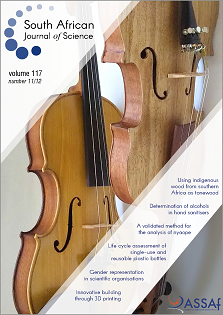Renewable energy potential of anaerobic mono- and co-digestion of chicken manure, goat manure, potato peels and maize pap in South Africa
DOI:
https://doi.org/10.17159/sajs.2021/10362Keywords:
anaerobic digestion, biomass, biomethane potential, energy mix, environment, renewable energyAbstract
The energy sector is an essential part of a country’s economy – it drives innovation and advances in industrialisation. Coal is the primary source of energy in South Africa. Coal contributes 95% of energy production; coal-fired power also contributes to greenhouse gas emissions, and is thus a hazard to human health and the environment. This calls for an energy mix that is renewable, sustainable, and affordable and that is carbon neutral (climate action). We investigated the potential of anaerobic mono-and co-digestion of goat manure, chicken manure, potato peels, maize pap, and cow manure inoculum for mesophilic recovery of renewable energy using the biomethane potential test. The substrates were characterised through proximate and ultimate analyses to determine the composition preferable for mono- and co-digestion. The key considerations in the determination of both the yield and production rate of methane from digestion of biomass are the substrate composition and characterisation. A high percentage of volatile solids favoured optimum biomethane production as highly volatile components provide microbes with balanced nutrients that enhance metabolic processes to produce biomethane. The mono-digestion process produced lower biomethane than did co-digestion. Higher production of biomethane by co-digestion was due to the balance of the micronutrients and macronutrients that favoured microbial metabolism and regulation of pH.
Significance:
- The results highlight the need for appropriate techniques in combining energy and waste management. Biogas could provide solutions for some of South Africa’s energy necessities, particularly in rural areas that have abundant biogas.
Published
Issue
Section
License

All articles are published under a Creative Commons Attribution 4.0 International Licence
Copyright is retained by the authors. Readers are welcome to reproduce, share and adapt the content without permission provided the source is attributed.
Disclaimer: The publisher and editors accept no responsibility for statements made by the authors
How to Cite
- Abstract 947
- PDF 788
- EPUB 251
- XML 248













.png)